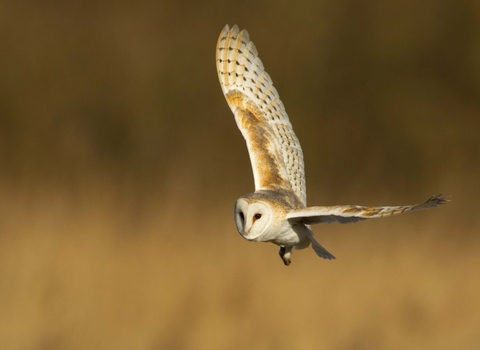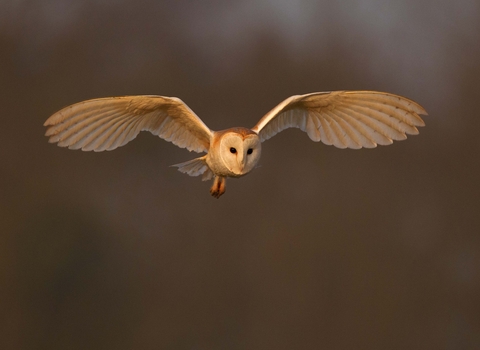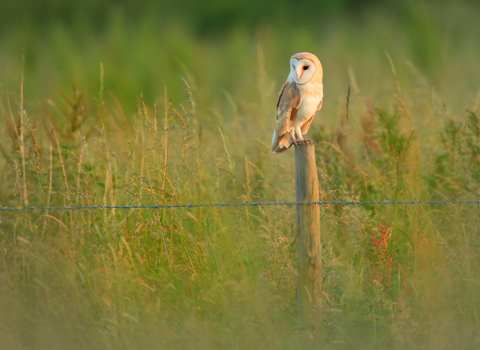
Barn owl ©Danny Green, 2020Vision

©Andy Rouse/2020VISION

©Jon Hawkins Surrey Hills Photography
Barn owl
Scientific name
Tyto albaWhen to see
January to DecemberSpecies information
Category
Statistics
Length: 33-39cmWingspan: 89cm
Weight: 300g
Average lifespan: 4 years
About
Perhaps our most familiar owl, the barn owl will sometimes hunt in the daytime and can be seen 'quartering' over farmland and grassland looking for its next small-mammal meal. However, it is perfectly adapted to hunt with deadly precision in the dark of night: combined with their stealthy and silent flight, their heart-shaped faces direct high-frequency sounds, enabling them to find mice and voles in the vegetation.How to identify
The barn owl has a mottled silver-grey and buff back, and a pure white underside. It has a distinctive heart-shaped, white face, and black eyes.Distribution
Widespread, but absent from the Highlands of Scotland and under threat in Northern Ireland.In our area
Barn owls are under serious threat in Northern Ireland with fewer than 30 breeding pairs estimated to be left and only a few known active nest sites. Once a familiar sight, this iconic bird has declined drastically, estimates suggest by as much as 60% since the 1930s. It is now one of our rarest and most endangered birds, red-listed on the Irish Birds of Conservation Concern and protected under the Wildlife (NI) Order 1985. Nest sites are protected all year round even if they are not in use.
Although nocturnal in Northern Ireland, on still moonlit evenings you might be able to spot a barn owl hunting over field edges and roadside verges for its next meal. Best places to see them include the Lough Neagh basin, south Down, the Ards Peninsula and the shores of Lough Foyle. Barn owls rely almost exclusively on small mammals, such as house mice and wood mice, given the absence of voles here, making them a great friend to farmers and homeowners alike.
Did you know?
Throughout history, barn owls have been known by many different nicknames, such as 'ghost owl', 'church owl' and 'screech owl'. But the name 'demon owl', in particular, illustrates how they were considered by some rural populations - something not so difficult to understand when you hear their piercing shrieks and hissing calls.Watch
Barn Owl by Russell Savory (https://vimeo.com/442049233)
Barn Owl by Russell Savory
Barn owls are under serious threat in Northern Ireland with fewer than 30 breeding pairs estimated to be left and only a few known active nest sites. Once a familiar sight, this iconic bird has declined drastically, estimates suggest by as much as 60% since the 1930s. It is now one of our rarest and most endangered birds, red-listed on the Irish Birds of Conservation Concern and protected under the Wildlife (NI) Order 1985. Nest sites are protected all year round even if they are not in use.
Although nocturnal in Northern Ireland, on still moonlit evenings you might be able to spot a barn owl hunting over field edges and roadside verges for its next meal. Best places to see them include the Lough Neagh basin, south Down, the Ards Peninsula and the shores of Lough Foyle. Barn owls rely almost exclusively on small mammals, such as house mice and wood mice, given the absence of voles here, making them a great friend to farmers and homeowners alike.
